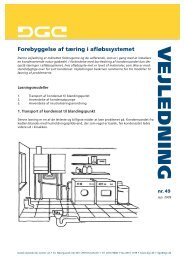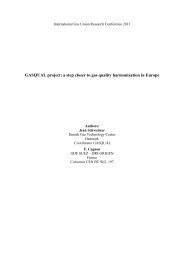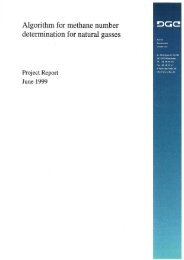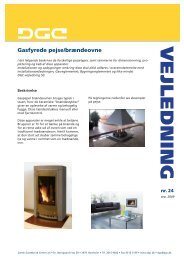The Composite Radiosity and Gap (CRG) Model of Thermal Radiation
The Composite Radiosity and Gap (CRG) Model of Thermal Radiation
The Composite Radiosity and Gap (CRG) Model of Thermal Radiation
You also want an ePaper? Increase the reach of your titles
YUMPU automatically turns print PDFs into web optimized ePapers that Google loves.
<strong>The</strong> <strong>Composite</strong> <strong>Radiosity</strong> <strong>and</strong> <strong>Gap</strong> (<strong>CRG</strong>) model <strong>of</strong> <strong>The</strong>rmal <strong>Radiation</strong><br />
ABSTRACT<br />
Niels Bjarne K. Rasmussen<br />
Danish Gas Technology Centre a/s<br />
DK-2970 Hørsholm, Denmark<br />
nbr@dgc.dk<br />
INFUB 2002 Conference, Estoril – Lisbon - Portugal<br />
Calculating the thermal radiation in furnaces <strong>and</strong> boilers has always been a problem <strong>of</strong><br />
choosing between complexity <strong>and</strong> simplicity which are related to high <strong>and</strong> low calculation<br />
time. <strong>The</strong> best choice will always be somewhere in between using models that are complex<br />
enough to describe the problem adequately <strong>and</strong> at the same time simple enough to be understood<br />
<strong>and</strong> used by the user.<br />
Especially in CFD you have to choose an economical model to get a solution within reasonable<br />
computing time. This new <strong>CRG</strong>-model <strong>of</strong> thermal radiation fits in that point. It gives<br />
analytically correct results for a number <strong>of</strong> examples covering the range between optically<br />
thick <strong>and</strong> optically thin cases <strong>and</strong> cases without participating medium (wall to wall radiation).<br />
<strong>The</strong> equation solved in the <strong>CRG</strong>-model is a simple diffusion equation. However, the model<br />
should not be mistaken for being the Diffusion model <strong>of</strong> radiation, which only works for optically<br />
very thick cases. For optically thick cases the <strong>CRG</strong>-model gives the same correct solution<br />
as the Diffusion method, while for optically thin cases (thickness zero) it gives the same<br />
solution as a simple wall to wall calculation. For two opposing infinite walls it gives the analytical<br />
solution. For any other geometry it gives plausible results.<br />
<strong>The</strong> bases <strong>of</strong> the <strong>CRG</strong> model are two models <strong>of</strong> Spalding: <strong>The</strong> <strong>Radiosity</strong> model <strong>and</strong> the IM-<br />
MERSOL model. <strong>The</strong> <strong>Radiosity</strong> model gives good results for optically thick cases like the<br />
Diffusion model, but it has a wider span than the diffusion model, meaning that it goes to a<br />
lower optical thickness. <strong>The</strong> IMMERSOL model by Spalding is made for calculating the radiation<br />
between IMMERsed SOLids in the topical fluid. <strong>The</strong> <strong>CRG</strong> model <strong>and</strong> the IMMER-<br />
SOL model have a lot in common, but <strong>CRG</strong> is more rigorously deduced than shown at the<br />
CHAM home page about IMMERSOL.<br />
<strong>The</strong> <strong>CRG</strong> model can be exp<strong>and</strong>ed to use “B<strong>and</strong> models” <strong>and</strong> “Sum <strong>of</strong> Grey Gases” <strong>and</strong> that<br />
without exp<strong>and</strong>ing the calculation time considerably. Some errors are corrected in the <strong>CRG</strong><br />
model compared to the IMMERSOL.<br />
<strong>The</strong> basic idea <strong>of</strong> the <strong>CRG</strong> model is to define a kind <strong>of</strong> “geometrical determined resistance <strong>of</strong><br />
radiation” for any point in the geometry. This additional “resistance” is based on a local figure<br />
<strong>of</strong> the “<strong>Gap</strong>” between the walls at that particular location. <strong>The</strong> calculation <strong>of</strong> the local “<strong>Gap</strong>”<br />
is done by a method also found by Spalding.<br />
<strong>The</strong> <strong>CRG</strong> model has been implemented as a user-subroutine in the CFD code STAR-CD. It<br />
gives excellent results <strong>and</strong> by a minimum <strong>of</strong> calculation time.<br />
Examples <strong>of</strong> the use <strong>of</strong> the <strong>CRG</strong> model for furnace calculations <strong>and</strong> for use in optimising radiant<br />
burners are presented.<br />
Keywords: <strong>The</strong>rmal radiation model, <strong>Composite</strong> <strong>Radiosity</strong> <strong>Gap</strong> (<strong>CRG</strong>), CFD, isotropic<br />
absorption, scattering, b<strong>and</strong> model, grey gases.
Introduction<br />
In most cases radiation models are used for finding the radiant source <strong>and</strong> sink terms for CFD<br />
modelling. <strong>The</strong>se terms are then put into the transport equation for enthalpy giving the temperature<br />
distribution in the topical case. Other results from the radiation models are the heat<br />
fluxes <strong>and</strong> heat transfer to the walls <strong>of</strong> the case in question. From this information the heat<br />
load on the boiler tubes or the furnaces walls can be calculated.<br />
Many models for thermal radiation include constants for the absorption coefficient a <strong>and</strong><br />
for the mean beam length L m . This is adequate for some special cases as cubic or spherical<br />
geometries with almost constant temperatures <strong>and</strong> concentrations. However, in most cases it<br />
is necessary to be able to use varying values <strong>of</strong> the mean beam length <strong>and</strong> the absorption. In<br />
the <strong>CRG</strong>-model there are no restrictions for the variation <strong>of</strong> these variables. However, the<br />
absorption <strong>and</strong> the scattering must be isotropic.<br />
<strong>The</strong> sink term <strong>of</strong> any point in the furnace is rather easily calculated, given from the fact that<br />
this term is only dependent on the conditions <strong>of</strong> the point in question. <strong>The</strong> source term at any<br />
point related to thermal radiation is however dependent on the condition <strong>of</strong> the whole furnace<br />
or geometry in question. <strong>The</strong> present model focuses on calculation <strong>of</strong> the source term for the<br />
thermal radiation.<br />
<strong>The</strong> <strong>Radiosity</strong> model<br />
<strong>The</strong> flux equation <strong>of</strong> thermal radiation, which is valid regardless <strong>of</strong> the optical thickness /1/, is<br />
given by:<br />
dqi<br />
= 4 a( eb<br />
− R)<br />
[W/m 3 ] (1)<br />
dx<br />
i<br />
where q i is the radiant flux. <strong>The</strong> term e b is given by :<br />
4<br />
e b<br />
= σT<br />
[W/m 2 ] (2)<br />
Above a is the absorption coefficient, σ is the Stefan Boltzmanns constant <strong>and</strong> T is<br />
the temperature in Kelvin <strong>of</strong> the fluid. <strong>The</strong> term R is the radiosity (W/m 2 ) which is the<br />
incoming radiation at any point. <strong>The</strong> total source term for the energy equation /1/ is found by:<br />
S<br />
rad<br />
dq<br />
( R − e )<br />
i<br />
= − = 4 a<br />
b<br />
[W/m 3 ] (3)<br />
dxi<br />
As pointed out above the sink term is relatively easily calculated. It is given by the equation:<br />
S<br />
rad, sink<br />
4<br />
= −4aσT<br />
[W/m 3 ] (4)<br />
<strong>The</strong> source term <strong>of</strong> radiation is much more difficult to calculate. <strong>The</strong> source term is found as<br />
the radiation coming in from all directions towards the topical point. This term is dependent<br />
on the conditions in all parts <strong>of</strong> the geometry, as thermal radiation does not follow the st<strong>and</strong>ard<br />
transport equation for a fluid scalar, <strong>and</strong> it comes from walls as well as from the gas itself.
For optically thick cases this term can be found by the <strong>Radiosity</strong> equation /1, 2/. <strong>The</strong> <strong>Radiosity</strong><br />
equation is found by setting up the approximation:<br />
q<br />
i<br />
4 dR<br />
= −<br />
[W/m 2 ] (5)<br />
3k<br />
dx<br />
i<br />
which combined with equation (1) gives the <strong>Radiosity</strong> equation:<br />
d ⎛ 4 dR ⎞<br />
0 = a( eb<br />
− R)<br />
dx<br />
⎜<br />
i<br />
k dx<br />
⎟ + 4<br />
[W/m 3 ] (6)<br />
⎝ 3<br />
i ⎠<br />
<strong>The</strong> extinction coefficient k is given by:<br />
k = a + s<br />
[m -1 ] (7)<br />
where s is the scattering coefficient.<br />
<strong>The</strong> <strong>Radiosity</strong> equation is valid for optically thick cases. However, it fails for optically thin to<br />
medium cases, which are the most common. <strong>The</strong> next section shows how to overcome this<br />
problem.<br />
<strong>The</strong> <strong>Composite</strong> <strong>Radiosity</strong> <strong>and</strong> <strong>Gap</strong> (<strong>CRG</strong>) model<br />
For optically very thick cases the fluid almost “can’t see” the walls around the fluid because<br />
<strong>of</strong> the optical thickness. However, for optically thin cases the walls are <strong>of</strong> importance. One<br />
case in which the analytical solution is known is the radiation between infinite plates <strong>of</strong> different<br />
temperature. <strong>The</strong> fluid in between is not participating in the radiation, i.e. the absorption<br />
<strong>and</strong> scattering are zero. <strong>The</strong> walls are black. <strong>The</strong> radiant flux between such plates is<br />
found by:<br />
q<br />
= −∆<br />
[W/m 2 ] (8)<br />
y<br />
e b<br />
in which the direction y is a normal to the plates. <strong>The</strong> term ∆e b is equal to σ(T 2 4 -T 1 4 ) .<br />
It is now assumed that a solution for R between the plates can be found by the approximation:<br />
∆e b dR<br />
=<br />
D dy<br />
[W/m 3 ] (9)<br />
<strong>The</strong> term D is the gap (distance) between the two walls. Equations 8 <strong>and</strong> 9 can be combined<br />
to give:<br />
dR<br />
q y<br />
= −D<br />
[W/m 2 ] (10)<br />
dy
By comparing the equations (10) <strong>and</strong> (5) it is obvious that there is a kind <strong>of</strong> analogy between<br />
the “stopping distance” 1/k related to the absorption <strong>of</strong> the fluid in the optically thick case<br />
<strong>and</strong> the effective geometrical “stopping distance” D in the optically thin case /2/. Now,<br />
taking the term k as being the “resistance <strong>of</strong> radiation” in the optically thick case <strong>and</strong> 1/D<br />
as being the “geometrical resistance” in the optically thin case, these two resistances can be<br />
summed up to give the resulting total extinction for calculation <strong>of</strong> the <strong>Radiosity</strong> R :<br />
4<br />
k' = k +<br />
[m -1 ] (11)<br />
3D<br />
<strong>The</strong> weight between k <strong>and</strong> 1/D could be different from the above but calculations <strong>of</strong><br />
different cases show that equation (11) gives good results. <strong>The</strong> resulting equation <strong>of</strong> the <strong>CRG</strong>model<br />
is then given by:<br />
d ⎛ 4 dR ⎞<br />
0 = + ( aT<br />
eb<br />
− aRR)<br />
dx<br />
⎜<br />
i<br />
k dx<br />
⎟ 4<br />
[W/m 3 ] (12)<br />
⎝ 3 '<br />
i ⎠<br />
In this equation the terms k’ <strong>and</strong> a may be constants. However, for most cases they are<br />
not constants <strong>and</strong> equation (12) can be solved for varying values <strong>of</strong> these terms. If gas radiation<br />
is considered the terms a T <strong>and</strong> a R may be different. This is due to the fact that the<br />
absorption a <strong>of</strong> gasses is temperature dependent. <strong>The</strong> temperature related to the <strong>Radiosity</strong><br />
R is found by:<br />
( R /σ ) 1/ 4<br />
T R<br />
= [K] (13)<br />
<strong>The</strong> absorptions a T <strong>and</strong> a R are then found at the temperatures T gas <strong>and</strong> T R .<br />
Equation (12) is merely a diffusion equation <strong>and</strong> is analogous to the conduction equation in<br />
solids including an energy source term.<br />
Now, let us look at equation (12) for different cases. When we have the optically thin case<br />
with radiation between two infinite plates the equation (12) reduces to:<br />
d ⎛ dR ⎞<br />
0 =<br />
⎜ D<br />
⎟<br />
[W/m 3 ] (14)<br />
dxi ⎝ dx i ⎠<br />
4<br />
When adding the boundary conditions at solid walls R w = σT w <strong>and</strong> solving for R the<br />
solution is found to satisfy the equation (8) for this case. In other words, equation (12) gives<br />
the analytically correct solution for this case.<br />
In the optically thick case the equation (12) reduces to equation (6), the <strong>Radiosity</strong> equation.<br />
As pointed out this equation is valid for optically thick cases. <strong>The</strong> question is now, how does<br />
the equation (12) behave in the case <strong>of</strong> medium optical thickness <strong>and</strong> how about the boundary<br />
conditions (BC). This is shown in the next section.
Boundary conditions<br />
<strong>The</strong> obvious boundary condition (BC) at walls is to extend the BC at the optically thin case to<br />
all cases (R w = σT w 4 ). However, this gives wrong solutions for optically medium <strong>and</strong> thick<br />
cases with energy source terms. In references /3/ <strong>and</strong> /4/ some analytical solutions for cases<br />
with medium optical thickness can be found. <strong>The</strong> cases have infinite parallel walls as above,<br />
but the walls have the temperature <strong>of</strong> 0K, the fluid participates with optical thickness from 0.1<br />
to 2.0, <strong>and</strong> a constant energy source term is introduced in the fluid. Only radiant heat transfer<br />
is considered. <strong>The</strong>re is a wall slip in temperature. This case could be considered as an idealised<br />
boiler situation with radiation from the fluid to the boiler walls <strong>and</strong> energy release by<br />
combustion in the fluid.<br />
Using equations (11) <strong>and</strong> (12) on this case gives solutions <strong>of</strong> the temperature within 2% <strong>of</strong> the<br />
correct analytical solutions. However, special BC’s have to be introduced for R . Using the<br />
BC’s from above gives too small temperatures <strong>and</strong> too small radiosities. <strong>The</strong> following BC<br />
gives the correct solution:<br />
R<br />
w<br />
4<br />
w<br />
σT<br />
+ C<br />
=<br />
1+<br />
C<br />
aD<br />
aD<br />
σT<br />
4<br />
c<br />
[W/m 2 ] (15)<br />
in which<br />
C aD<br />
= ln( aD +1) / ln(2)<br />
(16)<br />
In equation (15) T c is the temperature <strong>of</strong> the participating fluid in the computational cell<br />
adjacent to the topical wall boundary cell, or even better, the extrapolated fluid temperature at<br />
the wall (wall slip). <strong>The</strong> equations (15) <strong>and</strong> (16) are empirical equations. It might be possible<br />
to find even better equations but the above give very good results. <strong>The</strong> meaning <strong>of</strong> equation<br />
(15) is to change the BC at the wall in relation to the optical thickness aD <strong>of</strong> the case. With<br />
4<br />
no participating fluid the BC for R is σT w . With a participating fluid the BC for R<br />
4<br />
gets closer to σT c dependent on the optical thickness.<br />
When the emissivity <strong>of</strong> the walls are less than 1.0 some additional resistance <strong>of</strong> R at the<br />
walls must be introduced. From analytical solutions <strong>of</strong> the case with infinite walls above it<br />
can be deduced that the following transfer coefficient should be used at walls:<br />
h<br />
R<br />
⎛ 3⋅∆y<br />
⋅k'<br />
1<br />
=<br />
⎜ +<br />
⎝ 4 ε<br />
w<br />
⎞<br />
−1<br />
⎟<br />
⎠<br />
−1<br />
[-] (17)<br />
<strong>The</strong> terms ∆y <strong>and</strong> ε w are the distance from the wall to the cell mid point <strong>and</strong> the wall<br />
emissivity, respectively. Equation (17) gives the transfer coefficient for R between the cell<br />
adjacent to the wall <strong>and</strong> the wall. <strong>The</strong> flux <strong>of</strong> R at walls is equal to the total radiant flux at<br />
the walls.<br />
Special boundary conditions are necessary at baffles with heat conduction <strong>and</strong> for conjugate<br />
heat transfer.
Calculation <strong>of</strong> the <strong>Gap</strong><br />
In the cases presented above the gap D between the walls is very easily found. It is merely<br />
the distance between the plates. However, in general the gap is not that easily found. In such<br />
cases the gap is found by a method described in /2/. A variable L is defined. <strong>The</strong> equation<br />
for L is:<br />
d ⎛ dL ⎞<br />
0 =<br />
⎜<br />
⎟ +1<br />
(18)<br />
dxi ⎝ dx i ⎠<br />
This is another diffusion equation. L has the unit <strong>of</strong> (m 2 ) but it has no physical meaning.<br />
<strong>The</strong> BC <strong>of</strong> L is zero at all walls. From L it is possible to deduce the gap at any point in<br />
the geometry.<br />
2<br />
⎡⎛<br />
dL ⎞ ⎤<br />
D = 2⎢<br />
⎜<br />
⎟ + 2L⎥<br />
⎢⎣<br />
⎝ dxi<br />
⎠ ⎥⎦<br />
0.5<br />
[m] (19)<br />
Using equations (18) <strong>and</strong> (19) the gap related to any point in the geometry can be found. In<br />
the case <strong>of</strong> infinite plates above the solution will be the distance between the plates. In any<br />
other case the solution will be a very plausible measure <strong>of</strong> the gap at that point. <strong>The</strong> gap D<br />
is not a constant in an arbitrary shaped case. It will vary through the geometry.<br />
B<strong>and</strong> models <strong>and</strong> sum <strong>of</strong> grey gases<br />
<strong>The</strong> model is easily exp<strong>and</strong>ed to calculation <strong>of</strong> b<strong>and</strong> models or sum <strong>of</strong> grey gases for radiation.<br />
<strong>The</strong> <strong>Radiosity</strong> equation is solved for each b<strong>and</strong> or gas j <strong>and</strong> gives different R j for<br />
each b<strong>and</strong>. <strong>The</strong> absorption a j <strong>and</strong> the scattering s j <strong>of</strong> each b<strong>and</strong> or gas is used <strong>and</strong> proper<br />
BC’s included. <strong>The</strong> total radiant source is then:<br />
( a R a e )<br />
S = ∑4 −<br />
[W/m 3 ] (20)<br />
rad<br />
j<br />
Rj<br />
j<br />
Tj<br />
b<br />
When calculating the absorption coefficient <strong>of</strong> the participating gas a g the mean beam<br />
length L m <strong>of</strong> the radiation in the geometry has to be found. In most cases the a g is dependent<br />
on L m , which is a geometrical term only dependent on the local geometry. For infinite<br />
parallel plates in the examples above the L m is found by:<br />
L m<br />
= 2D<br />
[m] (21)<br />
This equation is assumed to be valid for all geometries. Traditionally, in many radiation models<br />
L m were assumed to be a constant throughout the geometry. With the above assumptions<br />
L m may vary which is very plausible <strong>and</strong> logical. L m given by (21) is only the geometrical<br />
mean beam length. In cases where absorbing fluids are present, the effective mean<br />
beam length is reduced accordingly, <strong>and</strong> it is calculated by a method not presented here.
Examples <strong>of</strong> the use <strong>of</strong> the <strong>CRG</strong> radiation model<br />
As shown above in the two analytical described cases with infinite walls the <strong>CRG</strong> model<br />
gives exact results within a few percent. <strong>The</strong>oretically, for optically thick cases the <strong>CRG</strong><br />
model gives exact results as the diffusion model. Some other examples <strong>of</strong> the use <strong>of</strong> this<br />
model will be given below.<br />
a) Flow <strong>and</strong> radiation in a confined self-recuperative radiant burner<br />
To be able to predict the conditions inside a confined self-recuperative burner the <strong>CRG</strong> model<br />
has been used to calculate the radiant heat transfer inside. <strong>The</strong> heat exchange is partly by convection<br />
<strong>and</strong> partly by thermal radiation. <strong>The</strong> flow <strong>and</strong> radiation was calculated by the use <strong>of</strong><br />
the STAR-CD CFD-model <strong>and</strong> including the <strong>CRG</strong> model in user-subroutines. With the calculations<br />
it was possible to predict possible performance for improved prototypes <strong>of</strong> the<br />
burner compared to the original. Below in Figure 1 <strong>and</strong> 2 is an example <strong>of</strong> calculation <strong>of</strong> the<br />
temperature field <strong>and</strong> the radiosity field for this burner.<br />
b) Flow <strong>and</strong> heat transfer in a burner tube for liquid heating<br />
<strong>The</strong> <strong>CRG</strong>-model has been used in CFD calculations <strong>of</strong> a burner tube for heating <strong>of</strong> liquids.<br />
<strong>The</strong> purpose was to find the maximum tube temperature at any point to see the risk <strong>of</strong> boiling<br />
on the outside <strong>and</strong> to compare with information from the manufacturer <strong>of</strong> the burner tube. <strong>The</strong><br />
results turned out to be very close to the information from the manufacturer, which was based<br />
on measurements. In the Figures 3 <strong>and</strong> 4 below the calculated temperature <strong>and</strong> radiosity in a<br />
plane through the axis <strong>of</strong> the tube are shown.<br />
c) Flow, combustion <strong>and</strong> radiation in a glass furnace with flame less oxidation<br />
In the third case the <strong>CRG</strong> model has been combined with an advanced combustion model for<br />
natural gas combustion in a glass furnace with a flame less oxidation burner. <strong>The</strong> combustion<br />
has been modelled including about 200 chemical reactions <strong>and</strong> 50 species. In this model the<br />
EDK model for combining turbulence <strong>and</strong> combustion has been used. <strong>The</strong> EDK model was<br />
presented at the INFUB97 conference. <strong>The</strong> <strong>CRG</strong> model has been included for the thermal<br />
heat transfer. <strong>The</strong> absorption coefficient <strong>of</strong> the gases is varying in the geometry dependent <strong>of</strong><br />
the concentrations, the temperature <strong>and</strong> the mean beam length <strong>of</strong> radiation.<br />
Conclusions<br />
A new model for thermal radiation has been developed. <strong>The</strong> model is called the <strong>Composite</strong><br />
<strong>Radiosity</strong> <strong>and</strong> <strong>Gap</strong> (<strong>CRG</strong>) model. <strong>The</strong> model is very economical in use, as the equations to be<br />
solved are pure diffusion equations. <strong>The</strong> model should not be mistaken for being the Diffusion<br />
model <strong>of</strong> radiation, which only works for optically very thick cases. <strong>The</strong> <strong>CRG</strong> model<br />
covers the whole range from optically very thin cases to optically thick cases. As shown<br />
above in the two analytically described cases with infinite walls the <strong>CRG</strong> model gives exact<br />
results within a few percent. This is totally adequate for practical use <strong>of</strong> the model in CFD <strong>and</strong><br />
in pure radiation cases. <strong>The</strong> model gives very plausible results in cases where the exact result<br />
is not known.<br />
<strong>The</strong> model is very easily implemented in CFD models for combustion <strong>and</strong> fluid flow. <strong>The</strong><br />
absorption <strong>and</strong> scattering coefficients, the mean beam length for radiation <strong>and</strong> the calculated<br />
“gap” at any point may vary throughout the geometry <strong>and</strong> need not be constants. <strong>The</strong> absorption<br />
<strong>and</strong> scattering must be isotropic.<br />
Special boundary conditions have to be included for walls <strong>and</strong> baffles <strong>and</strong> in case <strong>of</strong> conjugate<br />
heat transfer.
STAR<br />
PROSTAR 3.10<br />
13-Sep-01<br />
TEMPERATURE<br />
RELATIVE<br />
CELSIUS<br />
ITER = 6957<br />
LOCAL MX= 771.7<br />
LOCAL MN= 37.00<br />
750.0<br />
700.0<br />
650.0<br />
600.0<br />
550.0<br />
500.0<br />
450.0<br />
400.0<br />
350.0<br />
300.0<br />
250.0<br />
200.0<br />
150.0<br />
100.0<br />
50.00<br />
Z<br />
Y<br />
X<br />
Figure 1. <strong>The</strong> calculated temperature field inside <strong>of</strong> the confined burner. (°C)<br />
STAR<br />
PROSTAR 3.10<br />
28-Nov-01<br />
SC 2-R<br />
ITER = 6957<br />
LOCAL MX= 0.4887E+05<br />
LOCAL MN= 573.9<br />
0.4200E+05<br />
0.3900E+05<br />
0.3600E+05<br />
0.3300E+05<br />
0.3000E+05<br />
0.2700E+05<br />
0.2400E+05<br />
0.2100E+05<br />
0.1800E+05<br />
0.1500E+05<br />
0.1200E+05<br />
9000.<br />
6000.<br />
3000.<br />
-0.3906E-02<br />
Z<br />
Y<br />
X<br />
Figure 2. <strong>The</strong> calculated radiosity field inside <strong>of</strong> the confined burner. (W/m 2 )
STAR<br />
PROSTAR 3.10<br />
28-Nov-01<br />
TEMPERATURE<br />
ABSOLUTE<br />
KELVIN<br />
ITER = 957<br />
LOCAL MX= 1820.<br />
LOCAL MN= 298.5<br />
1834.<br />
1703.<br />
1572.<br />
1441.<br />
1310.<br />
1179.<br />
1048.<br />
917.0<br />
786.0<br />
655.0<br />
524.0<br />
393.0<br />
262.0<br />
131.0<br />
0.0000E+00<br />
Y<br />
X<br />
Z<br />
Figure 3. <strong>The</strong> calculated temperature in a plane through the axis <strong>of</strong> the tube. (K)<br />
STAR<br />
PROSTAR 3.10<br />
28-Nov-01<br />
SC 2-R<br />
ITER = 957<br />
LOCAL MX= 0.4788E+05<br />
LOCAL MN= 1070.<br />
0.5001E+05<br />
0.4644E+05<br />
0.4286E+05<br />
0.3929E+05<br />
0.3572E+05<br />
0.3215E+05<br />
0.2858E+05<br />
0.2500E+05<br />
0.2143E+05<br />
0.1786E+05<br />
0.1429E+05<br />
0.1072E+05<br />
7144.<br />
3572.<br />
-0.3906E-02<br />
Y<br />
X<br />
Z<br />
Figure 4. <strong>The</strong> calculated radiosity in a plane through the axis <strong>of</strong> the tube. (W/m 2 )
STAR<br />
PROSTAR 3.10<br />
05-Mar-01<br />
TEMPERATURE<br />
ABSOLUTE<br />
KELVIN<br />
ITER = 681<br />
LOCAL MX= 1778.<br />
LOCAL MN= 1402.<br />
1750.<br />
1675.<br />
1600.<br />
1525.<br />
1450.<br />
1375.<br />
1300.<br />
1225.<br />
1150.<br />
1075.<br />
1000.<br />
925.0<br />
850.0<br />
775.0<br />
700.0<br />
Y<br />
FLOX optimization<br />
X<br />
Z<br />
Figure 5. <strong>The</strong> calculated temperature field in a glass furnace. (K)<br />
STAR<br />
PROSTAR 3.10<br />
05-Mar-01<br />
SC 2-R<br />
ITER = 681<br />
LOCAL MX= 0.2762E+06<br />
LOCAL MN= 7334.<br />
0.2700E+06<br />
0.2600E+06<br />
0.2500E+06<br />
0.2400E+06<br />
0.2300E+06<br />
0.2200E+06<br />
0.2100E+06<br />
0.2000E+06<br />
0.1900E+06<br />
0.1800E+06<br />
0.1700E+06<br />
0.1600E+06<br />
0.1500E+06<br />
0.1400E+06<br />
0.1300E+06<br />
Y<br />
FLOX optimization<br />
X<br />
Z<br />
Figure 6. <strong>The</strong> calculated radiosity field in a glass furnace. (W/m 2 )
STAR<br />
PROSTAR 3.10<br />
05-Mar-01<br />
SC 5-ABC(IC)<br />
ITER = 681<br />
LOCAL MX= 3.189<br />
LOCAL MN= 0.4623E-02<br />
0.7000<br />
0.6500<br />
0.6000<br />
0.5500<br />
0.5000<br />
0.4500<br />
0.4000<br />
0.3500<br />
0.3000<br />
0.2500<br />
0.2000<br />
0.1500<br />
0.1000<br />
0.5000E-01<br />
0.0000E+00<br />
Y<br />
FLOX optimization<br />
X<br />
Z<br />
Figure 7. <strong>The</strong> calculated absorption coefficient in a glass furnace. (m -1 )<br />
References<br />
/1/ R. Siegel <strong>and</strong> J. R. Howell, <strong>The</strong>rmal <strong>Radiation</strong> Heat Transfer , Hemisphere, 1992<br />
/2/ Brian Spalding, Radiative Heat Transfer in Phoenics, CHAM home page,<br />
http://www.cham.co.uk/, 2001<br />
/3/ M. A. Heaslet <strong>and</strong> R. F. Warming, Radiative transport <strong>and</strong> wall temperature slip in an absorbing<br />
planar medium, Int. J. Heat Mass Transfer 8, 979-994, 1965<br />
/4/ N. B. K. Rasmussen et al., Numerical Integration Method <strong>of</strong> Radiative Exchange (NIM-<br />
REX), Int. J. Heat Mass Transfer 32, 343-350, 1989


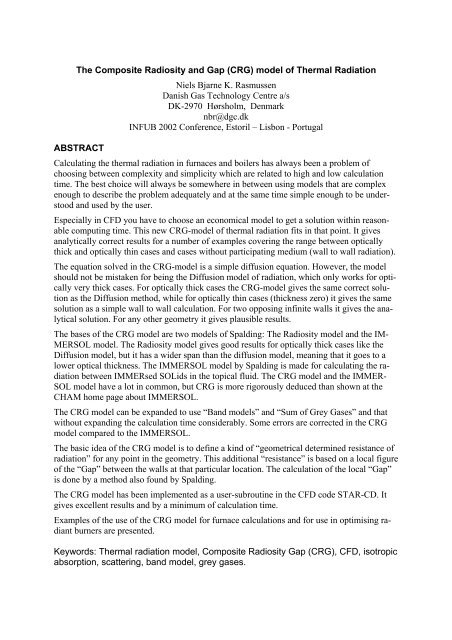
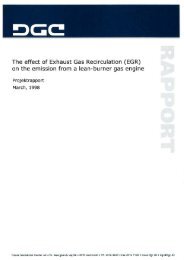


![Hybrid heating systems and smart grid [PDF] - Danish Gas ...](https://img.yumpu.com/46620218/1/184x260/hybrid-heating-systems-and-smart-grid-pdf-danish-gas-.jpg?quality=85)
